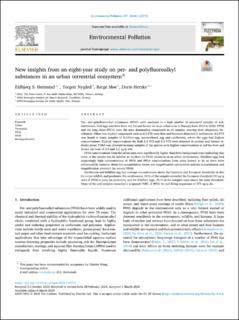| dc.contributor.author | Heimstad, Eldbjørg Sofie | |
| dc.contributor.author | Nygård, Torgeir | |
| dc.contributor.author | Moe, Børge | |
| dc.contributor.author | Herzke, Dorte | |
| dc.date.accessioned | 2024-03-21T08:14:20Z | |
| dc.date.available | 2024-03-21T08:14:20Z | |
| dc.date.created | 2024-03-20T12:31:37Z | |
| dc.date.issued | 2024 | |
| dc.identifier.citation | Environmental Pollution. 2024, 347, 123735. | en_US |
| dc.identifier.issn | 0269-7491 | |
| dc.identifier.uri | https://hdl.handle.net/11250/3123511 | |
| dc.description.abstract | Per- and polyfluoroalkyl substances (PFAS) were analysed in a high number of terrestrial samples of soil, earthworm, bird eggs and liver from red fox and brown rat in an urban area in Norway from 2013 to 2020. PFOS and the long chain PFCAs were the most dominating compounds in all samples, proving their ubiquitous distribution. Other less studied compounds such as 6:2 FTS were first and foremost detected in earthworm. 8:2 FTS was found in many samples of fieldfare egg, sparrowhawk egg and earthworm, where the eggs had highest concentrations. Highest concentrations for both 6:2 FTS and 8:2 FTS were detected at present and former industry areas. FOSA was detected in many samples of the species with highest concentrations in red fox liver and brown rat liver of 3.3 and 5.5 ng/g ww. PFAS concentrations from the urban area were significantly higher than from background areas indicating that some of the species can be suitable as markers for PFAS emissions in an urban environment. Fieldfare eggs had surprisingly high concentrations of PFOS and PFCA concentrations from areas known to be or have been influenced by industry. Biota-soil-accumulation factor and magnification calculations indicate accumulation and magnification potential for several PFAS. Earthworm and fieldfare egg had average concentrations above the Canadian and European thresholds in diet for avian wildlife and predators. For earthworms, 18 % of the samples exceeded the European threshold (33 ng/g ww) of PFOS in prey for predators, and for fieldfare eggs, 35 % of the samples were above the same threshold. None of the soil samples exceeded a proposed PNEC of PFOS for soil living organisms of 373 ng/g dw. | en_US |
| dc.language.iso | eng | en_US |
| dc.rights | Navngivelse 4.0 Internasjonal | * |
| dc.rights.uri | http://creativecommons.org/licenses/by/4.0/deed.no | * |
| dc.title | New insights from an eight-year study on per- and polyfluoroalkyl substances in an urban terrestrial ecosystem | en_US |
| dc.type | Peer reviewed | en_US |
| dc.type | Journal article | en_US |
| dc.description.version | publishedVersion | en_US |
| dc.rights.holder | © 2024 The Authors. Published by Elsevier Ltd. | en_US |
| dc.source.volume | 347 | en_US |
| dc.source.journal | Environmental Pollution (1987) | en_US |
| dc.identifier.doi | 10.1016/j.envpol.2024.123735 | |
| dc.identifier.cristin | 2256110 | |
| dc.relation.project | Miljødirektoratet: 16078185 | en_US |
| dc.relation.project | NILU: 115061 | en_US |
| dc.relation.project | NILU: 117065 | en_US |
| dc.relation.project | NILU: 113117 | en_US |
| dc.relation.project | NILU: 114042 | en_US |
| dc.relation.project | NILU: 116040 | en_US |
| dc.source.articlenumber | 123735 | en_US |
| cristin.ispublished | true | |
| cristin.fulltext | original | |
| cristin.qualitycode | 1 | |

